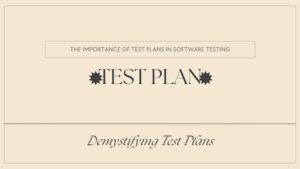Cracking the Interview: Top 30 Web Testing Interview Questions and Expert Answers (2023)
Web testing is a critical component of web development that ensures the functionality, usability, security, and performance of a website. Hiring managers look for candidates with a strong understanding of web testing principles and techniques.

In this article, we have compiled the top 30 web testing interview questions and answers to help you prepare for your next job interview.
Top 30 Web Testing Interview Questions and Answers
1. What is web testing, and why is it important?
Answer: Web testing is the process of evaluating the functionality, usability, security, and performance of a website. It ensures that the website is bug-free, user-friendly, and meets the user’s requirements. Web testing is important because it helps in identifying issues and improving the quality of the website.
2. What are the different types of web testing?
Answer: The different types of web testing are:
- Functional testing
- Usability testing
- Performance testing
- Security testing
- Compatibility testing
- Accessibility testing
- Regression testing
3. What is the difference between web testing and software testing?
Answer: Web testing is a subset of software testing that focuses on testing web applications. Software testing, on the other hand, is a broader term that includes testing all types of software applications.
4. What is a web application?
Answer: A web application is a software program that runs on a web server and can be accessed through a web browser. Examples of web applications include online shopping websites, social media websites, and online banking systems.
5. What is the difference between a web application and a website?
Answer: A website is a collection of web pages that are linked together and can be accessed through a web browser. A web application, on the other hand, is a software program that runs on a web server and can be accessed through a web browser.
6. What is functional testing?
Answer: Functional testing is the process of testing the functionality of a web application. It ensures that the web application is working as expected and all the features are functioning correctly.
7. What is usability testing?
Answer: Usability testing is the process of testing the user-friendliness of a web application. It ensures that the web application is easy to use and navigate.
8. What is performance testing?
Answer: Performance testing is the process of testing the speed, scalability, and stability of a web application. It ensures that the web application can handle a large number of users and perform well under heavy load.
9. What is security testing?
Answer: Security testing is the process of testing the security of a web application. It ensures that the web application is secure and cannot be hacked or exploited.
10. What is compatibility testing?
Answer: Compatibility testing is the process of testing the compatibility of a web application with different browsers, devices, and operating systems. It ensures that the web application works correctly on all types of devices and platforms.
11. What is accessibility testing?
Answer: Accessibility testing is the process of testing the accessibility of a web application for people with disabilities. It ensures that the web application can be used by people with different disabilities, such as visual, hearing, and motor impairments.
12. What is regression testing?
Answer: Regression testing is the process of testing a web application after making changes to ensure that the existing functionality is not affected.
What are the different tools used for web testing?
Answer: The different tools used for web testing are:
- Selenium
- Appium
- TestComplete
- LoadRunner
- JMeter
- SoapUI
- Postman
14. What is Selenium?
Answer: Selenium is an open-source tool used for automating web browsers. It supports different programming languages, such as Java, Python, and C#, and can be used for functional testing, regression testing, and browser compatibility testing.
15. What is JMeter?
JMeter is an open-source Java-based software application that is primarily used for load testing and performance testing of web applications. Developed by the Apache Software Foundation, JMeter is widely used in software testing and is known for its scalability, versatility, and ability to simulate a high volume of users accessing a web application simultaneously.
16. What is LoadRunner?
LoadRunner is a commercial performance testing tool that allows testers to simulate different levels of load and stress on web applications to test their performance. Developed by Micro Focus, LoadRunner is widely used in software testing and is known for its ability to support a wide range of protocols, including HTTP, HTTPS, FTP, and SOAP, among others.
17. What is SoapUI?
SoapUI is an open-source testing tool used for testing web services.
18. What is BrowserStack?
BrowserStack is a cloud-based testing tool used for cross-browser testing.
19. What is a test plan?
A test plan is a document that outlines the testing strategy, test objectives, and testing schedule for a web application. A test plan is a document that outlines the strategy, objectives, and procedures for testing a product or system. It is a comprehensive and detailed document that provides guidance to the testing team and stakeholders about how testing will be conducted throughout the project.
20. What is a test case?
A test case is a document that describes the steps to be followed to test a specific functionality of a web application.
21. What is a test scenario?
A test scenario is a document that describes a hypothetical situation that a user may encounter while using a web application.
22. What is a bug?
A bug is an error or defect in a web application that causes it to behave in an unintended way.
23. What is a defect report?
A defect report is a document that describes a bug or defect found during testing, including the steps to reproduce it and the expected behavior.
24. What is exploratory testing?
Exploratory testing is the process of testing a web application without a predefined test plan or script, relying on the tester’s experience and intuition to find defects.
25. What is boundary value analysis?
Boundary value analysis is a testing technique that involves testing values at the boundaries or limits of a range.
26. What is equivalence partitioning?
Equivalence partitioning is a testing technique that involves dividing a range of values into equivalent partitions and testing one value from each partition.
27. What is negative testing?
Negative testing is the process of testing how a web application behaves when it receives unexpected or invalid input.
28. What is positive testing?
Positive testing is the process of testing how a web application behaves when it receives expected or valid input.
29. What is load testing?
Load testing is the process of testing how a web application behaves under normal and peak loads.
30. What is Fiddler?
Fiddler is a free web debugging tool that allows testers to inspect and analyze HTTP traffic between web browsers and web servers.
Conclusion:
Web testing is a critical process in ensuring that web applications meet their intended goals and provide a positive user experience. By understanding the different types of web testing interview questions and answers you would be able to crack the interview.







One Comment